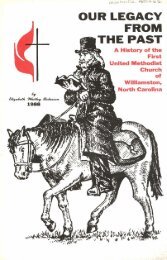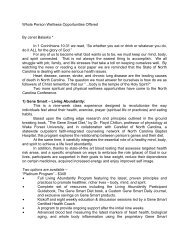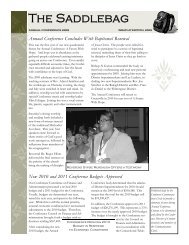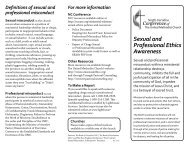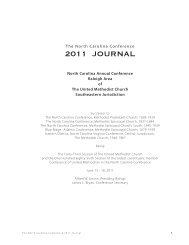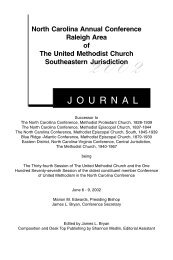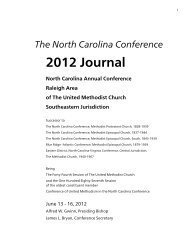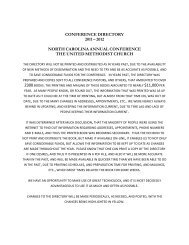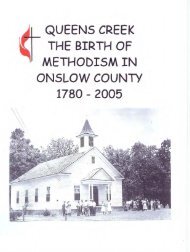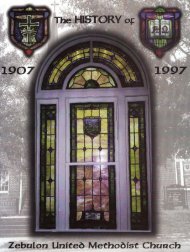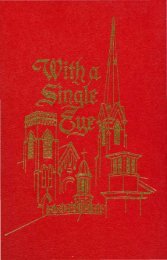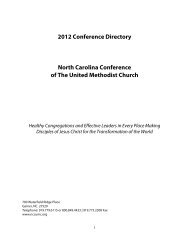Facing Tomorrow, Understanding Yesterday, A History of Orange ...
Facing Tomorrow, Understanding Yesterday, A History of Orange ...
Facing Tomorrow, Understanding Yesterday, A History of Orange ...
Create successful ePaper yourself
Turn your PDF publications into a flip-book with our unique Google optimized e-Paper software.
FACING TOMORROW, UNDERSTANDING YESTERDAY 17<br />
1885, for instance, <strong>Orange</strong> County elected its first board <strong>of</strong> education,<br />
whichsupervised thirty-eight public schools in the county, one <strong>of</strong> which<br />
wasnamed <strong>Orange</strong> Church School. This one-room school was located<br />
nearthe creek northeast <strong>of</strong> <strong>Orange</strong> Church, behind the present ball field.<br />
Thelandthat the school occupied was not church property at the time and<br />
therewas no formal connection between the two, but the school, nevertheless,identified<br />
with the nearby church through its name. Some <strong>of</strong> the<br />
facultymembers were LizzieWeaver Blackwood (later Freeland), Maude<br />
Faucette,Margaret Claytor, and EarI Freeland.<br />
By 1915,a Community Club <strong>of</strong> <strong>Orange</strong> Church was organized at the<br />
schoolhouse.Committee structure for this organization was a bit different<br />
fromthat <strong>of</strong> today. One committee, for instance, was assigned to pickling,<br />
canning,and preserving chores, and another was responsible for keeping<br />
upthe school and church grounds. The Community Club was closely tied<br />
to<strong>Orange</strong> Church despite the lack <strong>of</strong> <strong>of</strong>ficial ties to the church. Many <strong>of</strong><br />
itsmembers belonged to the church, and the school building served as<br />
thesite <strong>of</strong> many church activities because fund-raising and other recreationalprograms<br />
were not allowed in the sanctuary. At that time, <strong>of</strong><br />
course,the church had no extra buildings in which to hold such activities.<br />
Clubmembers were active fund raisers for both the church and the<br />
school.<br />
Surviving minutes for the years 1915-1918show that the club under- Earl Freeland, teacher <strong>of</strong> <strong>Orange</strong> Church<br />
tooka variety <strong>of</strong> activities to benefit the church, school, and community. School- 1904<br />
ForHomecoming Day in May 1915,for instance, the club sponsored a love<br />
feastatwhich money was received to purchase hymn books. The club also<br />
setaside $8-$10for the purchase <strong>of</strong> an organ for the church, only to find<br />
outthat they had to appropriate $15 instead. Members also worked hard<br />
tokeepthe schoolyard clean. They held work days, just as later members<br />
<strong>of</strong><strong>Orange</strong> Church would do. During these sessions, Community Club<br />
membersdivided the school land into subplots and assigned parents and<br />
theirchildren particular areas to spruce up. The women planted flowers<br />
andinvolved the schoolchildren in preparing the schoolyard for grass<br />
seed.Inaddition, club members bought window shades at 35 cents apiece<br />
forthe school. The women had thought that the shades would cost 50<br />
centsapiece, which would have put a bigger dent in their treasury. The<br />
lowerprice was much appreciated.<br />
To finance their various activities for the church and the school, the<br />
womenlevied annual dues <strong>of</strong>20 cents apiece. In addition, they sponsored<br />
fund-raisingactivities such as a benefit concert by the Carolina Glee Club<br />
in 1917 and a box party in 1916, in which single women prepared<br />
attractivelydecorated boxes <strong>of</strong> food for two that were then auctioned <strong>of</strong>f<br />
tosinglemen. The men bought both the food and the cook with their bids.<br />
In mid-1915, the club's married women joined the <strong>Orange</strong> County<br />
SanitationLeague in an effort to help keep "<strong>Orange</strong> County clean and<br />
healthy."And in mid-1918, the club decided to buy a testament for "each<br />
boyinthe district that had to go to [military] camp]une 25."As with some<br />
women'sgroups today, the church women <strong>of</strong> this era spent some time in<br />
sewingcircles, passing the time by socializing and making a quilt that<br />
wouldbe sold to benefit the school. After the United States entered WorId<br />
WarI, much <strong>of</strong> the sewing was done for the Red Cross.<br />
The school and the club likely still were in existence after WorId War<br />
I,butrecords cannot be found to substantiate the club's activities after that<br />
time.The University's North Carolina Room has a 1922 map <strong>of</strong> <strong>Orange</strong><br />
Countyschools that shows that the school was still in existence at that<br />
time.At some later undetermined time, the building was torn down. The<br />
propertyon which the school stood at one time is now owned by the<br />
church.



